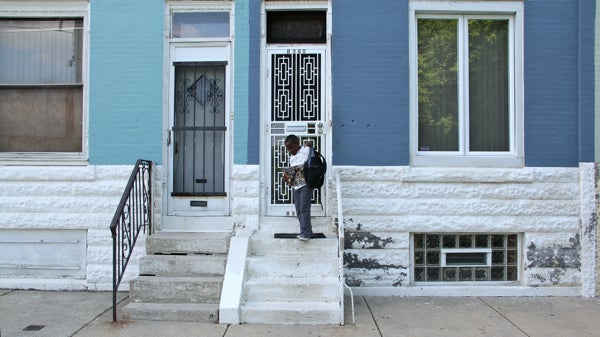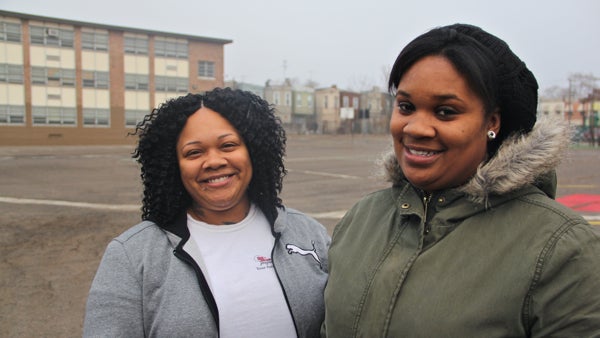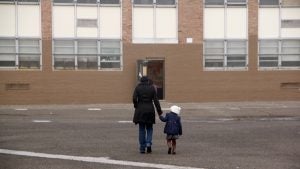Part Three: Redemption
The turnaround at Blaine Elementary turns out to be more about momentum than test scores.
Listen 8:36
Keith Gray supervises his grandson's homework. Little Keith will be a first grader at Blaine Elementary this fall. (Emma Lee/WHYY)
The turnaround at Blaine Elementary turns out to be more about momentum than test scores.
At a raucous parent meeting I attended, one man sat silently in the back of the room.
I had hoped to talk with him after the meeting ended, but he slipped away before I had the chance to introduce myself.
The next day, though, I answered a phone call at my desk downtown from a man named Keith Gray.
“Well what made me call you was it seemed like you were only getting a one-side story of the school,” he said.
Gray’s grandson, also named Keith, will enter the first grade this fall. Through Little Keith’s kindergarten year, Gray volunteered at the school most days. He got to know Blaine Elementary’s principal, Gianeen Powell, pretty well, and after learning who I was, asked her for my number.
“She didn’t ask me to do this,” he said. “I asked her if I could contact you, because I thought it wasn’t fair.”
A few days later, I visited Gray on his block in Strawberry Mansion. We sat in a leafy abandoned lot across from his house where the neighbors maintain the grass and have patio furniture and bar-b-que grills set up.

In 2009, when Little Keith was still in his mother’s womb, his father, also named Keith, was murdered.
“He was at a nightclub down in Center City, 3rd and Market. Got into an argument with another guy. And I think they were pushing and shoving, whatever have you and it was squashed,” said Gray.
The bouncer kicked the other guy out first.
“And then my son came out, I don’t know, 15-20 minutes later. And as soon as he walked out, the guy confronted him,” he said. “They struggled, and the guy shot him in the chest.”
Gray’s son was 29 years old. Little Keith’s mother was 5 ½ months pregnant.
Over the next few years, Gray stayed in his grandson’s life. And the more he spent time with him, the more he could see that he needed him.
That became especially apparent when this past school year started. Little Keith should have started Kindergarten in September with the rest of the kids at Blaine, but, living with his mom, it wasn’t happening.

“I’m kind of a stickler for education, but she wasn’t so much,” said Gray. “That’s when I totally just said, just let him stay here with me and I can get him there everyday.”
In early October, Little Keith moved in with his grandfather full time. At that point, he had missed weeks of school.
“He needed to be with me so he could get to school,” Gray said. “You can read in between the lines, other than that he would have constantly been late, wouldn’t have been there.”
At first, it was an adjustment.
“I was a single man. I could go out. Whenever I wanted to go out, I’d just go out. Can’t do that now. If I didn’t want to come straight home from work, I didn’t have to,” he said. “He’s changed my whole lifestyle.”
Quickly, though, Gray began to relish the new routine. Every morning, the pair would get up at 6:45 a.m., brush their teeth together, and eat breakfast. He’d iron Little Keith’s clothes, pack him a lunch, and then walk him and a few of the other kids on the block to school.
The more he spent time with little Keith, the more he reminded him of his son, and Gray seemed to be presented an opportunity for redemption.
“They’re the same. They actually look alike. He’s outspoken, very inquisitive. He wants to know everything,” said Gray. “He’s like the reincarnation of his father. He’s growing the same way.”
This time, though, Gray is counting on a much different outcome.
“Any mistakes I might have made with the first, I get to do over,” said Gray, tears welling in his eyes. “It’s like a do-over.”
He says the biggest mistake he made with his son was not spending enough time with him as a boy.
“We spent more time as an adult than I did with him as a child. And that’s different now with him,” said Gray. “You know, it’s not money or anything, it’s the time that you spend. And that’s the biggest thing that I learned. You can pay what you need to pay and all that, but if you aren’t spending time, I mean, what are you doing?”
“It’s not money or anything, it’s the time that you spend. And that’s the biggest thing that I learned.”
During school hours, Gray works the sign-in desk at Blaine and helps keep order during lunch periods.
Being there almost everyday, Gray says he’s gotten a day-to-day view of the turnaround attempt.
“What have I seen? I’ve seen a hard job,” said Gray.
He’s says the school has served Little Keith especially well. He came into school behind, but has now caught up and is near a first-grade level of abilities.
“He’s learning. He likes to go to school,” said Gray. “That’s self explanatory. He likes to go to school. He doesn’t like missing school.”
How to judge?
Blaine’s turnaround effort is not yet a story that has a definitive ending. There have been no triumphant celebrations, nor any sorrowful admissions of defeat.
After year one of what Principal Powell sees as a five-year process, they are still very much operating in the eye of the storm.
And the very question of how to measure the success of such an effort is debateable.
One way is to simply track the collected data points and compare the year-to-year results. Essentially: Did the state test scores go up? Did the rate of violent incidents go down?
In Blaine’s case, the answer to both questions is no, but the numbers are tricky.
The state says it’s tests got a lot harder last year, so comparisons to the previous year are unfair. Preliminary numbers at Blaine’s show that scores fell a little more sharply than the state average in English, but much less sharply than the state average in math.
Compared to district averages, Blaine fared slightly better in both subjects, more so in math.
As for violent incidents, data from the school district show that they went up in the turnaround year. Eleven were reported this past year; four the year before.
But Principal Powell says the numbers don’t tell the real story in that staff in previous years didn’t always follow through in reporting incidents.
Another way to evaluate the turnaround is much more subjective.
“Last year it was a tragedy. Like, it was crazy, but it’s way better now,” said Tierra White, who’s sixth-grade daughter has been at Blaine since kindergarten. “The teachers are better. They do more stuff. They got more activities.”

Some of the students testified to that as well.
Karim Pressley, who will enter seventh grade this year, said the school felt safer this past year based on the “new rules.”
Principal Powell says, actually, nothing changed year to year about the rules, which are anchored to a positive behavior program. Only now, all faculty members are singing from the same hymnal.
“I mean we did those things, but maybe all the children didn’t know the process. I think we’re very transparent, and everybody knows what’s going to happen. So this year, everybody knows. All staff know, all the children know, all the parents know.”
For math teacher Andrew Brooking, progress in academics and culture was a day-by-day judgement. Everyday, he kept a running tally of good days and bad days.
Good days were those when his classrooms would be humming, students were engaged, and he could see the light in their eyes growing. Bad days were the opposite, where gains seemed marginal and the challenges of the neighborhood felt unsurmountable.
As winter turned to spring, “good days” gathered momentum.
“Overall, I can count on my hand that I went home and had a day where I was like, ‘Oh, this is horrible,'” he said.
From Principal Powell’s perspective, it’s clear that academic performance at the school has risen. But she admits that she and the staff often felt like they were building an airplane midflight.
“You just wish, you know, that you just know all the answers before you’re actually doing the work. So, it’s a process,” said Powell. “They have to learn, and I’m learning too.”

“It’s a process. They have to learn and I’m learning too.”
For some, Blaine’s turnaround will forever be marked by the sudden, drastic shakeup in faculty. It’s a decision that still resonates to some degree in the halls of the school.
Rasheed Abdullah, the teacher who’s been at Blaine longer than anyone, says that the changeover did bring in some really good teachers. He says many of those who were pushed to leave hadn’t been at the school that long, and didn’t have much buy-in.
“The students can kinda feel you out, and they know if you truly care or not.”
But there were a few who had been there longer who he misses — teachers he knew gave their all to the kids.
“I think we lost some of those types of teachers,” said Abdullah. “And I think that’s very important to the success of the teachers and the success of the students, because the students can kinda feel you out, and they know if you truly care or not.”
To Maureen Brower, a six-year Blaine veteran, there’s no doubt it was the right thing to do.
“I really see a difference with the adults in the building just kinda collaborating, and really working together to make this a great school.”
“I really see a difference with the adults in the building just kinda collaborating and really working together to make this a great school,” said Brower.
One of the true tests of the shakeup will be if the new teachers actually stay.
That was a question Andrew Brooking wrestled with throughout the year.
For him, the turning point came in the spring. By then, he felt truly immersed in the school community. He felt supported by Principal Powell, and the rest of the staff, and he began to really see the difference the turnaround was having.
That last point really crystallized for him at a faculty meeting late in the year. Staff met to compare their goals at the beginning of the turnaround process with their progress thus far.
“When I sat back and I looked at each category, I was like, ‘Wow,'” said Brooking. “And I said it to the whole team, I was like, ‘Ok, I can sit back and say I’m sorry for — I don’t know if it’s pushing us — but sorry for feeling like we’re not ever doing good enough work.”
It was in that meeting that Brooking was struck by Blaine’s momentum.
“I was like, ‘No. We’ve done a lot of work. We have to start somewhere,”” he said.
For Principal Powell, many challenges remain. School culture is far from perfect. Too many students still too often arrive at school late, and budget concerns continue to permeate everything.
But Powell is not just hopeful. She’s confident.
“I know that our children are growing. I believe that any child who comes here, if I just know where they are — even if they are two, three years below level — I will take them at least a year and a half within that year,” she said. “I know that our children will grow.”
Of last year’s faculty, all but four members will return this year. Two took administrative positions in other schools. Two transferred to other teaching positions.
Andrew Brooking will be one of those who will return. At the end of the year, he came to Principal Powell to tell her he’d commit to at least the full five-year turnaround.
“I can see the change in the kids. I can feel the change.”
“I can see the change in the kids. I can feel the change. I can see more desire. It’s one year, but to see them from the beginning of the year to the end of the year, I feel proud of the work that they’ve done, and that I’ve done,” he said. “I feel like, if I were to walk away, it would be detrimental to the school. And that’s not just me as a person, I feel like the work that’s done, the foundation that’s set, that needs to be consistent now.”
As the turnaround effort moves into its second year, its success or failure will not be contingent on Principal Powell, or Andrew Brooking, or Rasheed Abdullah or any one individual.
What became clear through reporting this story, the turnaround of such a school — with such deep needs — can only thrive in the long term when all parties acknowledge the dire importance of the work.
From school and district leaders, to teachers, to parents, to the students themselves, to city and state politicians, to citizens across the commonwealth, the responsibility at Blaine is shared.
WHYY is your source for fact-based, in-depth journalism and information. As a nonprofit organization, we rely on financial support from readers like you. Please give today.




